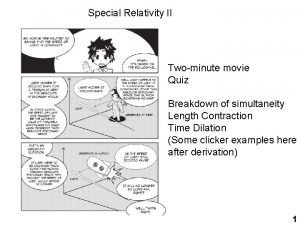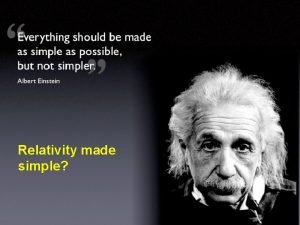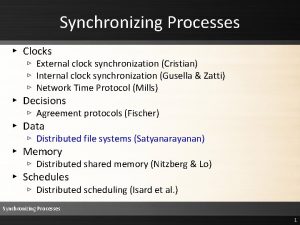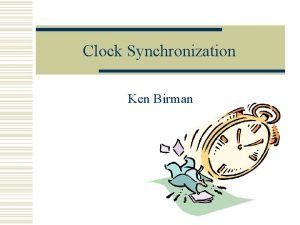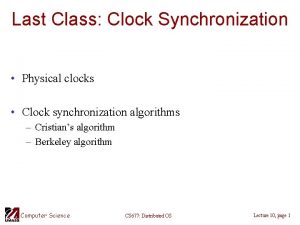Module 3 Clock Synchronization and Simultaneity Synchronization The








- Slides: 8

Module 3 Clock Synchronization and Simultaneity

Synchronization • The proper time is the time interval between two events that occur at the same point in some reference frame. § It can therefore be measured on a single clock. • In another reference frame moving relative to the first, the same two events occur at different places, so two clocks are needed to record the times. • This procedure requires that the clock be synchronized. 2

Synchronous Clocks • In order to have a time scale valid for an entire frame of reference, we must have a number of clocks distributed throughout the frame so that there will everywhere be a nearby clock which can be used to measure time in its vicinity. • These clocks my be synchronized. 3

Asynchronous Clocks • If two clocks are synchronized in the frame in which they are at rest, they will be out of synchronization in another frame. • In the frame in which they are moving, the chasing clock leads (shows a later time) by an amount where LP is the proper distance between the clocks. 4

Simultaneity • Two events that take place at the same instant of time, though not necessarily at the same point in space, are said to occur simultaneously. • Common sense tells us that if two events occur simultaneously according to one person, these events must occur simultaneously from the point of view of all observers. Wrong. • In special relativity, simultaneity does not have an absolute meaning independent of the spatial coordinates, as it does in the classical theory. 5

Definition of Simultaneity • Two instants of time t 1 and t 2, observed at two points x 1 and x 2 in a particular frame, are simultaneous if light signals simultaneously emitted from the geometrically measured midpoint between x 1 and x 2 arrive at x 1 at t 1 and at x 2 at t 2. light signal x 1 x 2 midpoint 6

Simultaneity in Relativity • t 1 and t 2 are simultaneous if light signals emitted at t 1 from x 1 and at t 2 from x 2 arrive at the midpoint simultaneously. • Two events which are simultaneous when viewed from one frame of reference are in general not simultaneous when viewed from a second frame which is moving relative to the first. 7

Lightning Bolt Train Example S S’ S t 0 B’ B C’ C t 1 > t 0 v A’ B’ A C’ B C A’ v A S’ S t 2 > t 1 S’ B’ B C’ C A 8


